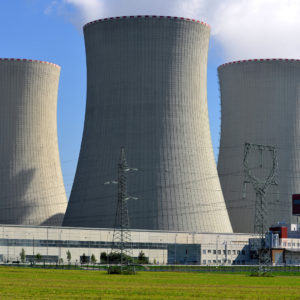Forty five years ago, it looked like nuclear energy would power America’s future. In a 1973 report, the U.S. Atomic Energy Commission predicted that 1000 reactors would power homes and businesses across the U.S. by the start of the 21st century. Instead, new plant construction stalled because of environmental concerns and fears about public safety. Now, this generation of aging reactors is rapidly coming offline. The remaining 100 plants are struggling to compete with low-cost natural gas under a regulatory structure that does not play to nuclear’s strengths of reliability and consistency.
“It’s not safety. It’s not reliability. It’s the market and federal policies that don’t recognize the value that nuclear energy provides to this country,” Exelon Chief Nuclear Officer Bryan Hanson told the Asbury Park Press when the Oyster Creek plant in New Jersey shut down earlier this month.
In 2010, Exelon agreed to close the plant before its projected end-of-life to avoid being required to build costly cooling towers to meet upgraded environmental standards. Like other nuclear power stations, the Oyster Creek plant found it difficult to compete with cheap natural gas. In Pennsylvania, the Three Mile Island reactor is also likely to close early unless state lawmakers are able to develop a specific plan to save it. All told, a quarter of the currently-operating nuclear reactors are predicted to retire by 2021 as closures continue and perhaps accelerate.
Nuclear power has produced about 20 percent of U.S. electricity for decades. Just a decade ago, they were seen as a key part of the American fuel mix. Since then, the rapid decline in natural gas prices and increased focus on wind and solar as carbon-free alternatives has hurt the industry’s competitiveness.
At both the state and federal level, lawmakers are considering ways to help prop up struggling plants, including subsidizes and pricing rules. So far, the situation has remained murky, as both sides attempt to work out who should take the lead. This summer, PJM, a major east-coast power transmission company, filed two different plans before the Federal Energy Regulatory Committee (FERC). One would have created a two-stage capacity market to handle the price impacts of subsidized resources, the other would have expanded a minimum price rule to subsidized energy sources.
FERC rejected both solutions.
This has left states that hope to save nuclear power in an uncertain situation. Either of the two proposals would have given states a framework to support nuclear power. Instead, they are left to try to help local reactors to compete in an interstate market that does not play to their strengths.
Unlike natural gas generators or other renewable sources like wind and solar, nuclear generators can not be easily cycled on and off in response to fluctuations in demand. Their strength is providing steady baseload power. However, current power pricing schemes on the capacity market, which connects generators to utility companies, do not factor in the reliability or carbon emissions status of a generation source.
“The status quo, in which markets recognize only short-term price signals and ignore the essential role of nuclear generation, will lead to more premature shutdowns of well-run nuclear facilities. Once closed, these facilities are shuttered forever,” said Maria Korsnick, president and chief executive officer of the Nuclear Energy Institute, after FERC opened proceedings to evaluate resilience in the bulk capacity markets early this year.
Meanwhile, state-level efforts to support these plants risk intruding into interstate capacity markets, which are generally regulated by FERC at the federal level. State legislators in states like Pennsylvania, where Three Mile Island is located, have been waiting for federal guidance on the matter, but are growing concerned that no decision is forthcoming.
While they are waiting, nuclear plants will continue to struggle to compete on price alone, especially as they age. In part, plant closures reflect the realities of aging equipment. Many plants planned and built in the late 1960s originally had 40-year operating licenses. In some cases, these licenses were later extended, but as the plans continue to operate past their planned closure dates, necessary maintenance and repairs become increasingly expensive.
“The [Oyster Creek’s] original 40-year license, which expired in 2009, had been extended 20 years by the Nuclear Regulatory Commission (NRC). However, the plant would have required the installation of cooling towers, at a cost of about $800 million, to meet new environmental standards,” says David Gattie, associate professor of environmental engineering at the University of Georgia, and a strong proponent of nuclear power.
As time passes, regulatory uncertainty is becoming an increasing concern for America’s remaining 99 operating reactors. Unless state and federal rulemakers come to a consensus relatively quickly, America’s nuclear industry may find itself on an almost inescapable downward spiral. However, a leaked document this summer hinted that the Department of Energy might be willing to support subsidies for nuclear power. So far, no official plan has yet been announced.

